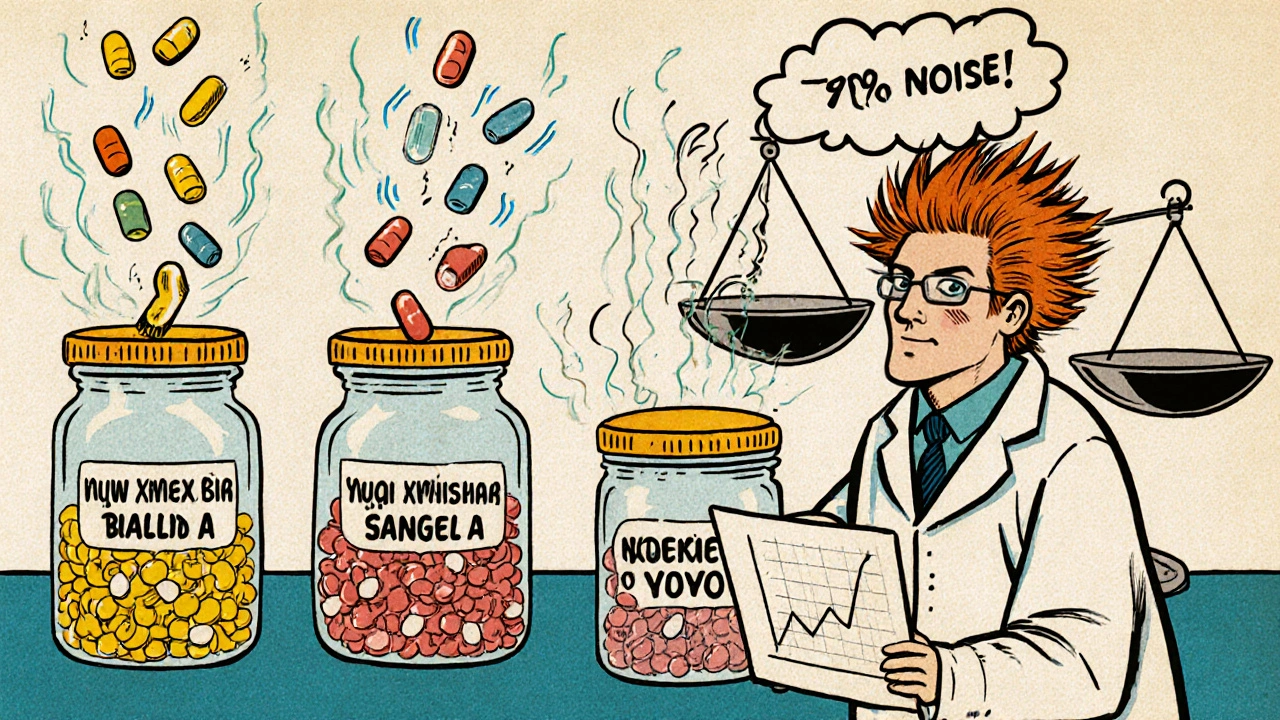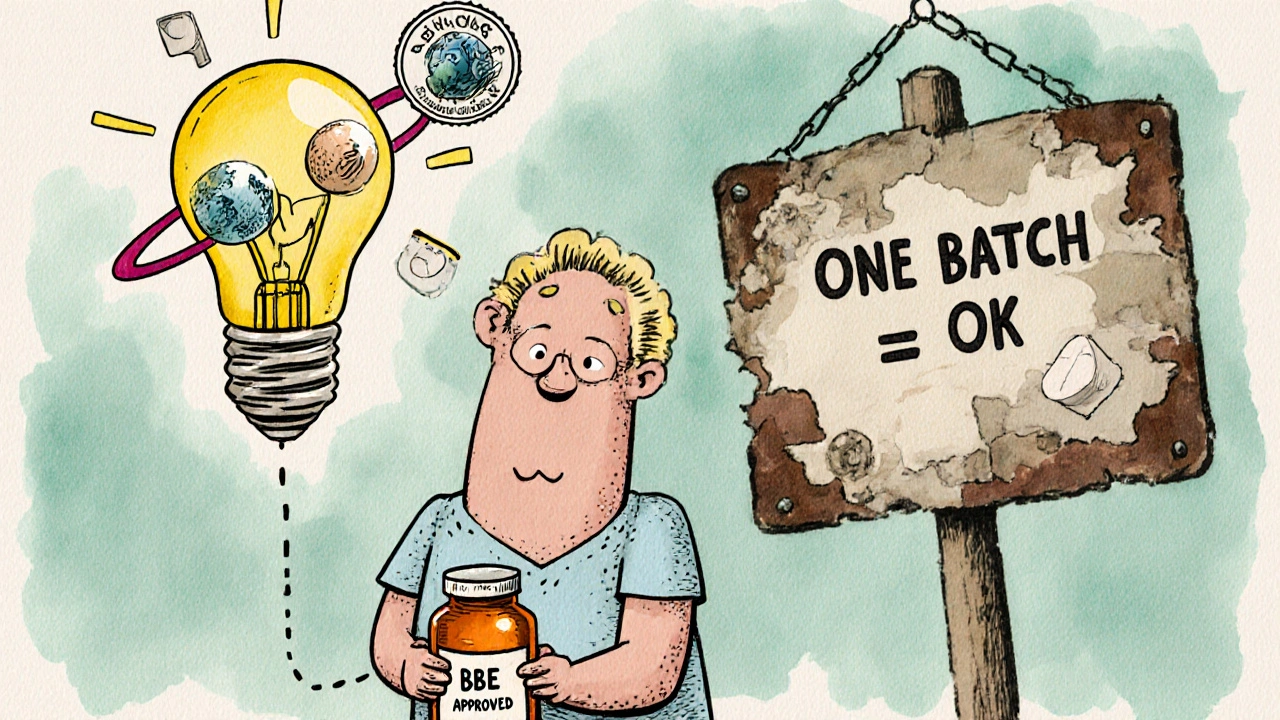Batch Variability and Bioequivalence: What Acceptable Limits Really Mean for Generic Drugs
 Nov, 14 2025
Nov, 14 2025
When you pick up a generic pill at the pharmacy, you assume it works just like the brand-name version. But what if the batch of generic drug you’re holding was made under slightly different conditions than the one tested in the lab? What if the reference brand itself varies from batch to batch - and no one’s accounting for it? This isn’t science fiction. It’s the quiet flaw at the heart of how we decide if a generic drug is safe and effective.
What Bioequivalence Actually Means - and What It Doesn’t
Bioequivalence is the gold standard for approving generic drugs. If a generic product delivers the same amount of active ingredient into your bloodstream at the same speed as the brand-name drug, regulators say it’s equivalent. The standard test? Compare the bioequivalence of two products using two key numbers: AUC (total drug exposure) and Cmax (peak concentration). The results must fall within an 80% to 125% range of the brand-name drug’s values. That’s it. If it’s in that range, the drug gets approved. But here’s the problem: this test is almost always done using just one batch of the generic and one batch of the brand. That’s like judging whether two cars are identical by testing one red 2023 Honda Civic against one blue 2023 Honda Civic - and assuming all Civics are the same. In reality, manufacturing isn’t perfect. Even the same factory, using the same recipe, will produce slight differences between batches. These aren’t defects. They’re normal variations in particle size, coating thickness, or dissolution rate. And they matter. A 2016 study in Clinical Pharmacology & Therapeutics found that batch-to-batch variability accounts for 40% to 70% of the total error in bioequivalence studies. That means up to 70% of the noise you see in test results isn’t from how your body absorbs the drug - it’s from how the drug was made. When you ignore that, you’re not measuring true equivalence. You’re measuring luck.The Hidden Risk: When Bioequivalence Tests Lie
Imagine two generic versions of the same drug. Both are made by the same company. One batch has a 5% higher dissolution rate. The other has a 5% lower rate. Neither is defective. Both meet quality specs. But if you test the high-dissolution batch against a low-dissolution brand batch, the results might show the generic is not bioequivalent - even though it’s perfectly fine. Or worse: if you test the low-dissolution generic against a high-dissolution brand batch, you might wrongly say they’re equivalent. That’s not science. That’s statistical noise. This isn’t theoretical. Researchers have shown that when batch variability is high, conventional bioequivalence studies can misclassify products more than 10% of the time - far above the accepted 5% error rate. That means one in ten generic drugs approved under today’s rules might not perform the same in real patients. And the reverse is true too: perfectly good generics get rejected because they were tested against an unrepresentative batch. Dr. Robert Lionberger, former head of the FDA’s Office of Generic Drugs, called this one of the biggest statistical oversights in modern drug regulation. He wasn’t exaggerating. The 80-125% rule was designed for simple, low-variability drugs. It wasn’t built for inhalers, nasal sprays, or complex injectables - where tiny changes in manufacturing can change how the drug behaves in the body.What’s Being Done? The Rise of Multi-Batch Testing
The old way - one batch, one test - is crumbling. New guidance from regulators is pushing for change. In 2022, the FDA started requiring manufacturers of nasal spray products to test at least three production-scale batches of both the generic and the brand. The EMA is moving in the same direction. Why? Because you can’t trust a single point. You need to see the pattern. The new approach is called Between-Batch Bioequivalence, or BBE. Instead of comparing the average response of one generic batch to one brand batch, BBE compares the average difference between test and reference to the natural variability seen across multiple batches of the brand itself. If the generic’s average performance falls within the range of how much the brand varies from batch to batch, it’s considered equivalent. Think of it like this: if the brand’s Cmax values vary between 80 and 120 ng/mL across five batches, and your generic’s average is 100 ng/mL, then it’s within the brand’s own natural range. You don’t need it to match exactly. You just need it to be as consistent as the brand. Simulations show that with just three reference batches, BBE correctly identifies true bioequivalence 65% of the time. With six batches, that jumps to over 85%. That’s a massive improvement. And crucially, it doesn’t require more patients. Just more batches.
What This Means for Complex Drugs
This isn’t just about pills. It’s critical for drugs where delivery matters. Nasal sprays, inhalers, topical creams, and injectables are all highly sensitive to minor manufacturing differences. A change in propellant pressure, particle size, or emulsion stability can drastically alter how much drug reaches the target tissue. For these products, single-batch testing is dangerously inadequate. The FDA’s guidance on budesonide nasal spray already acknowledges this. It asks manufacturers to separate “super-batch variability” (the variation across all batches of a product) from individual patient variability. That’s a step forward. But it’s still product-specific. What’s needed is a universal standard. That’s why the European Federation for Pharmaceutical Sciences (EUFEPS) called in 2021 for immediate regulatory action. And why the EMA’s 2023 workshop on complex generics listed “inadequate consideration of batch-to-batch variability” as one of the top three challenges in generic drug development.What Manufacturers Are Doing Now
The industry isn’t waiting for regulators to catch up. A 2022 survey by the Generic Pharmaceutical Association found that 78% of major generic manufacturers now test multiple batches for complex products - up from just 32% in 2018. Why? Because they’ve seen the data. They’ve seen their products get rejected over noise. They’ve seen lawsuits over inconsistent performance. They know the risk. More companies are now using mixed-effects statistical models that can separate batch variability from individual patient variability. They’re running replicated crossover studies. They’re submitting characterization data for five, six, even ten batches. It’s expensive. It’s time-consuming. But it’s the only way to ensure real equivalence. The International Council for Harmonisation (ICH) is also stepping in. Its new draft guideline Q13 on continuous manufacturing includes requirements for statistical methods that assess consistency across manufacturing scales - a direct response to batch variability concerns.
The Future: What You Can Expect by 2025
By 2025, the standard for bioequivalence will look very different. Expect these changes:- Minimum of three reference batches and two test batches required for complex generics
- Mandatory use of mixed-effects models that separate batch, within-subject, and residual variability
- Widening of acceptance ranges based on actual reference product variability - not a fixed 80-125%
- Increased scrutiny of dissolution profiles across multiple batches
- Regulatory submissions will need batch-to-batch consistency data as standard, not an exception
Why This Matters to You
You might think this is just a regulatory technicality. But it’s not. If a generic drug isn’t truly bioequivalent, it could mean:- Lower effectiveness - your asthma inhaler doesn’t open your airways as well
- Increased side effects - your blood pressure pill causes dizziness because it releases too fast
- Therapeutic failure - your seizure medication doesn’t prevent episodes
What is the standard bioequivalence limit for generic drugs?
The standard bioequivalence limit is a 90% confidence interval for the ratio of geometric means between the generic and brand-name drug, falling within 80.00% to 125.00% for key pharmacokinetic parameters like AUC and Cmax. This is set by the FDA and EMA and applies to most simple oral solid dosage forms.
Why is batch-to-batch variability a problem in bioequivalence testing?
Batch-to-batch variability can account for 40-70% of the total error in bioequivalence studies. If only one batch of each product is tested, the results may reflect random manufacturing differences rather than true drug performance. This can lead to false conclusions - either approving inequivalent drugs or rejecting good ones.
What is Between-Batch Bioequivalence (BBE)?
Between-Batch Bioequivalence (BBE) is a newer method that compares the average performance of a generic drug to the natural variability seen across multiple batches of the brand-name drug. Instead of using a fixed 80-125% range, BBE adjusts the acceptance criteria based on how much the reference product itself varies from batch to batch. This provides a more accurate assessment of true equivalence.
Which types of drugs are most affected by batch variability?
Drugs with complex delivery systems are most affected, including nasal sprays, inhalers, topical creams, and injectables. These products rely on precise particle size, formulation stability, and release mechanisms - all of which can vary slightly between manufacturing batches and significantly impact how the drug works in the body.
Will generic drugs become more expensive because of multi-batch testing?
In the short term, testing multiple batches increases development costs. But in the long run, it reduces the risk of product rejections, delays, and recalls. Companies that adopt robust testing early are more likely to get approval on the first try, saving time and money. Ultimately, this leads to more reliable generics - not fewer or more expensive ones.
Are regulatory agencies changing their rules?
Yes. The FDA released a draft guidance in June 2023 proposing formal inclusion of batch variability in bioequivalence studies. The EMA is also reviewing its guidelines with public consultation completed in 2023. Both agencies expect new requirements to be finalized by 2024-2025, mandating multi-batch testing for complex generics.
How many batches should be tested for reliable bioequivalence?
Experts recommend testing at least three batches of the reference product and two batches of the test product for complex generics. This provides enough data to accurately estimate between-batch variability and avoid false conclusions. For simpler drugs, one batch may still suffice - but the trend is clearly moving toward multi-batch testing across all categories.
